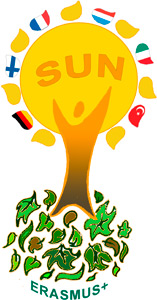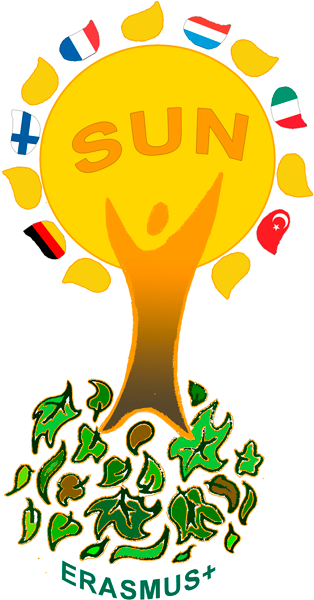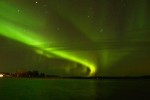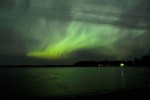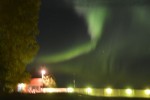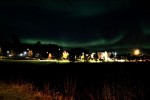Northern lights
Taivaanilmiöt – Effects in the sky
Optiset ilmiöt-Optical effects
Revontulet/(Eteläntulet)
Aurora Borealis/Australis:
Revontulet ovat valoilmiöitä, jotka koostuvat värikkäistä, tanssivista ja vaihtelevista kuvioista yötaivaalla. Mitä kauemmaksi päiväntasaajasta mennään, sitä enemmän näitä valoilmiöitä nähdään– Suomessa ne ovat yleisimpiä Lapissa talviaikaan. Revontulet syntyvät aurinkotuulen varattujen hiukkasten osumisesta Maan ilmakehään. Voimakkaimmat revontulet näkyvät yleensä suurien Auringon koronassa tapahtuneiden purkausten jälkeen.
Revontulien alkuperä on siis Aurinko, 149 miljoonan kilometrin päässä maasta. Auringosta lähtevät hiukkaset kulkeutuvat aurinkotuulena 300–1 000 km/s nopeudella Maapalloa kohti, kantaen mukanaan Auringon magneettikenttää. Maan magneettikenttä suojelee Maata aurinkotuulen hiukkasilta ja säteilyltä. Aurinkotuuli vääristää maan magneettikentän komeetan hunnun muotoiseksi magnetosfääriksi eli avaruuden osaksi, johon taivaankappaleen magneettikenttä vaikuttaa dominoivasti. Suurin osa varatuista hiukkasista kiertää maan magneettikentän kenttäviivoja pitkin, mutta osa hiukkasista jää magneettikentän vangiksi. Hiukkaset kiertyvät magneettikentän mukana kohti napa-alueita ja muodostavat ilmakehään osuessaan revontulia. Voimakkaimmat revontulet syntyvät noin 100 kilometrin korkeudessa maan pinnasta.
Revontulien ulkonäkö vaihtelee. Pitkät kaaret ja säteet alkavat 100 kilometrin korkeudesta, ja jatkuvat ylöspäin magneettikenttää pitkin satoja kilometrejä. Kaaret voivat olla vain 100 metriä ohuita, mutta ne saattavat ulottua horisontista horisonttiin. Revontulet saattavat olla lähes paikoillaan ja sitten ennalta arvaamatta alkaa kääntyä ja tanssia. Puolenyön jälkeen revontulet voivat muuttua laikullisiksi ja vilkkua kymmenen sekunnin välein aina aamuun asti. Revontulet ovat usein väriltään keltaisenvihreitä, mutta korkeat säteet voivat muuttua ylä- ja alaosastaan punaisiksi. Joskus harvoin auringonvalo osuu revontulien yläosiin luoden hailakkaan sinisen värin. Noin kymmenen vuoden välein, revontulet voivat muuttua kokonaan syvänpunaisiksi ylhäältä alas asti. Valon lisäksi varatut hiukkaset tuottavat lämpöä, joka säteilee pois infrapunasäteilynä tai kulkeutuu yläilmakehän voimakkaiden tuulten mukana pois.
English:
The northern lights – Aurora Borealis
or
The southern lights – Aurora australis
Northern lights (Aurora borealis) are light effects, that consist of colorful, dancing and variable patterns in the night sky. What further from the equator you go the more you see this kind of light effects-in Finland they’re most common in Lapland during the winter. Aurora Borealis are born when charged particles of the solar wind hit the atmosphere. The strongest Aurora borealis usually appears after a big discharge in the corona of the sun.
Origin of Northern lights is the sun, 149 kilometers away from the earth. Particles leaving from the sun are moving as solar wind with the speed of 300-1000 kilometers per second towards the earth, carrying magnetic field of the sun. Magnetic field of the Earth is protecting it from particles and radiation of the solar wind. Solar wind distorts magnetic field of the Earth to a magnetosphere, that has shape of the comet’s coma. Magnetosphere is a part of the space, where the magnetic field of a celestial body effects with a dominating force. Most of the charged particles circle along the field lines of the Earth’s magnetic field, but some of the particles remain captive by the magnetic field. Particles twist with the magnetic field towards the polar regions and form Northern ligths when they hit the atmosphere. Strongest Northern lights are born 100 kilometers away from the ground.
Look of the Northern lights varies. Long arches and beams are starting to form at the height of 100 kilometers and continue hundreds of kilometers higher along the magnetic field. The arches can be only 100 meters thick, but they might extend from horizon to horizon. Northern lights may almost stay still and the unpredictably start to turn and dance. After midnight Northern lights can become spotted and blink every 10 seconds till the morning. Usually Northern lights are usually yellow green, but high beams might turn to red from top and bottom. Very rarely the sunlight may hit upper parts of the Northern lights and create a faded blue color. Approximately every ten years Northern lights might become deep red from top to bottom. Alongside light, charged particles release some heat, that beams away as infrared radiation and passes away with winds of the upper Atmos-phere.
Kuvia-Pictures:
revontulia Kuopion Väinölänniemellä
Haloilmiöt:
Haloilmiö eli halo on ilmakehän optinen ilmiö, joka ilmenee taivaalla näkyvinä erilaisina renkaina, kaarina ja kirkastumina. Halot syntyvät, kun Auringon tai Kuun valo taittuu tai heijastuu ilmassa leijuvista jääkiteistä.
Tavallisesti halot esiintyvät Auringon, Kuun tai keinovalojen lähettyvillä, mutta sopivissa olosuhteissa erilaisia halomuotoja nähdään koko taivaan alueella. Välillä halot ovat väriltään lähinnä valkoisia, kun taas joissakin on selvästi havaittavissa kaikkia spektrin värejä, minkä takia värikäs halo saattaa sekoittua sateenkaareen. Kiteiden rakenne, niiden asento leijaillessa kohti maata sekä Auringon tai vastaavan valonlähteen korkeus vaikuttavat siihen, millaisia taivaalle muodostuvat halot ovat.
Erilaisten halomuotojen yleisyydet vaihtelevat paljon. Tavallisimpia havaitaan keskimäärin yli satana päivänä vuodessa, kun harvinaisimmista on vain yksittäisiä tunnettuja havaintoja. Harvinaisten halomuotojen esiintyminen vaatii yleensä tarkalleen tietynmuotoisia jääkiteitä, kiteiden on oltava optisesti riittävän virheettömiä ja asennon oltava leijuttaessa oikea. Suurikokoisten halojen harvinaisuutta selittää myös niiden himmeys.
Halot syntyvät tavallisesti 5–10 kilometrin korkeudella harso- ja untuvapilvissä, jotka peittävät taivasta ohuen huntumaisena. Kun esimerkiksi Auringon tai Kuun valo kulkee tällaisen pilviverhon läpi, voi samalla syntyä myös haloja. Tietynlaisissa keskipilvissä, kuten verhopilvissä ja sadejuovaisissa hahtuvapilvissä, voi myös muutaman kerran vuodessa esiintyä haloja ja talven pakkaskeleillä haloilmiöitä aiheuttavat myös lähellä maanpintaa leijailevat jääkiteet.
Toisinaan halot saattavat näkyä tunteja, kun keliolosuhteiden vaikutuksesta halonäytös saattaa joskus jäädä hyvinkin lyhyeksi. Esimerkiksi sivuaurinko saattaa ohi liikkuvassa cirrus-kuidussa tulla näkyviin vain muutaman kymmenen sekunnin ajaksi ja himmetä sitten näkymättömiin. Useimmiten halot ovat melko himmeitä, mutta saattavat toisinaan herättää huomiota jopa sateenkaarta kirkkaampina. Monia himmeän valkeita haloja voi olla vaikea erottaa sitä ympäröivän pilven kirkkaammista tihentymistä. Kirkastuman pysyessä paikallaan valonlähteen (esim. Auringon) suhteen, pilven liikkeestä huolimatta, voi melko luotettavasti varmistua siitä, että kyseessä on haloilmiö. Yleensä yläpilvet liikkuvat silmin nähden hitaasti, jolloin tarkkailu ennen kuin halo havainnon varmistumista saattaa viedä aikaa.
Halo effects:
Halo effect (simply known as halo) is an optical effect at the atmosphere that can be seen as different circles, curves and defecations in the sky. Halos are born when sunlight or moonlight breaks or reflects through ice crystals that are floating in the air.
Halos are usually visible near sunlight, moonlight or artificial lights but with the right conditions different halo shapes are shown in the whole sky area. Sometimes halos are quite white, while others are glowing in the colors of spectrum and that’s why you might shuffle them to rainbow. Structure of the crystal, its position when it’s floating towards the ground and height of the sun or similar light source are effecting to the halos that are forming at the sky.
Commonness of the halo shapes toggles a lot.The most regular ones are spotted on hundred days a year when the rare ones are only detected a few times. Appearance of the rare halo shapes usually requires precisely shaped ice crystals, crystals have to be optically flawless enough and the position has to be right while floating. Rareness of the big halo shapes is also explained by their haze.
Halos are usually born at the height of 5 to 10 kilometers in cirrostratus clouds
and cirrus clouds, which cover the sky as thin and veil-like. For example when sunlight or moonlight travels through this kind of cloud curtain there may develop some Halo effects. In certain medium clouds, like in a curtain of clouds and rain streaked altocumulus clouds may couple times a year appear halo effects and in cold winter weather halo effects cause ice crystals near the ground. Sometimes Halos may appear for hours, and sometimes the impact of weather conditions may leave the halo screening very short. For example page sun may appear on passing by Cirrus-fiber for couple of ten seconds and dash away. Mostly Halos are quite matt, but sometimes they may draw attention as being even brighter than rainbows. Many matt white Halos might be hard to recognize from the brightest condensations of the cloud that is surrounding them. When the defecation is staying still in relation to the light source (sun for example), despite movement of the clouds, you can quite reliably ensure that it is a halo effect. Usually the high clouds are moving seemingly slowly, when the observation before the halo effect is confirmed might take some time.
Kuvia – Pictures:
22 asteen rengas
